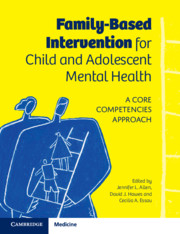Book contents
- Family-Based Intervention for Child and Adolescent Mental Health
- Family-Based Intervention for Child and Adolescent Mental Health
- Copyright page
- Contents
- Contributors
- Preface
- Part I Theoretical Perspectives on Family-Based Intervention
- Part II Core Clinical Competencies
- Part III Family Intervention for Specific Child and Adolescent Mental Health Problems
- Chapter 8 A Family-Based Approach to the Treatment of Youth Depression
- Chapter 9 A Family-Based CBT Approach to the Treatment of Anxiety Disorders in Children and Adolescents
- Chapter 10 Case Complexity and Resistance to Change in the Treatment of Child Conduct Problems
- Chapter 11 Enhancing Engagement and Motivation with Adolescents with ADHD and Their Parents
- Chapter 12 Functional Family Therapy for Antisocial Behaviour in Adolescents
- Chapter 13 Autism Spectrum Disorders in Young Children
- Chapter 14 Family-Based Treatment for Eating Disorders
- Chapter 15 Sleep Problems
- Part IV Family Intervention for Children at Risk Due to Family Dysfunction or Past Adversity
- Part V New Developments in Family-Based Intervention
- Index
- References
Chapter 11 - Enhancing Engagement and Motivation with Adolescents with ADHD and Their Parents
The Supporting Teens’ Autonomy Daily (STAND) Model
from Part III - Family Intervention for Specific Child and Adolescent Mental Health Problems
Published online by Cambridge University Press: 18 February 2021
- Family-Based Intervention for Child and Adolescent Mental Health
- Family-Based Intervention for Child and Adolescent Mental Health
- Copyright page
- Contents
- Contributors
- Preface
- Part I Theoretical Perspectives on Family-Based Intervention
- Part II Core Clinical Competencies
- Part III Family Intervention for Specific Child and Adolescent Mental Health Problems
- Chapter 8 A Family-Based Approach to the Treatment of Youth Depression
- Chapter 9 A Family-Based CBT Approach to the Treatment of Anxiety Disorders in Children and Adolescents
- Chapter 10 Case Complexity and Resistance to Change in the Treatment of Child Conduct Problems
- Chapter 11 Enhancing Engagement and Motivation with Adolescents with ADHD and Their Parents
- Chapter 12 Functional Family Therapy for Antisocial Behaviour in Adolescents
- Chapter 13 Autism Spectrum Disorders in Young Children
- Chapter 14 Family-Based Treatment for Eating Disorders
- Chapter 15 Sleep Problems
- Part IV Family Intervention for Children at Risk Due to Family Dysfunction or Past Adversity
- Part V New Developments in Family-Based Intervention
- Index
- References
Summary
Family therapies for adolescents with attention deficit hyperactivity disorder (ADHD) face notorious engagement problems related to population-specific barriers. Supporting Teens’ Autonomy Daily (STAND) is an empirically-supported engagement-focused therapy for parents and teens with ADHD. In this chapter, we step into the lives of adolescents with ADHD and their parents, uncovering why therapeutic behavior change historically eluded this population. We describe the STAND model and discuss specific strategies that therapists can employ to enhance parent and teen engagement. Our approach draws from social psychology research on human motivation, change-oriented therapies such as motivational interviewing (MI), research on therapy homework and habit formation, behavioral principles and our own trial and error working with families. We share the results of three clinical trials that established STAND’s efficacy and discuss limitations and future directions for the evolving STAND model. We invite readers to collaborate with us in this process, creating their own brand of STAND to improve the lives of families.
- Type
- Chapter
- Information
- Family-Based Intervention for Child and Adolescent Mental HealthA Core Competencies Approach, pp. 136 - 151Publisher: Cambridge University PressPrint publication year: 2021
References
- 1
- Cited by



